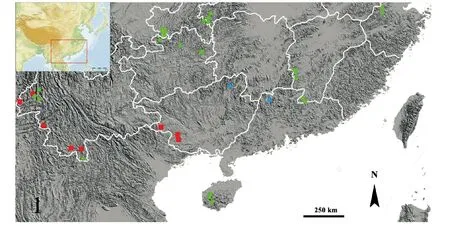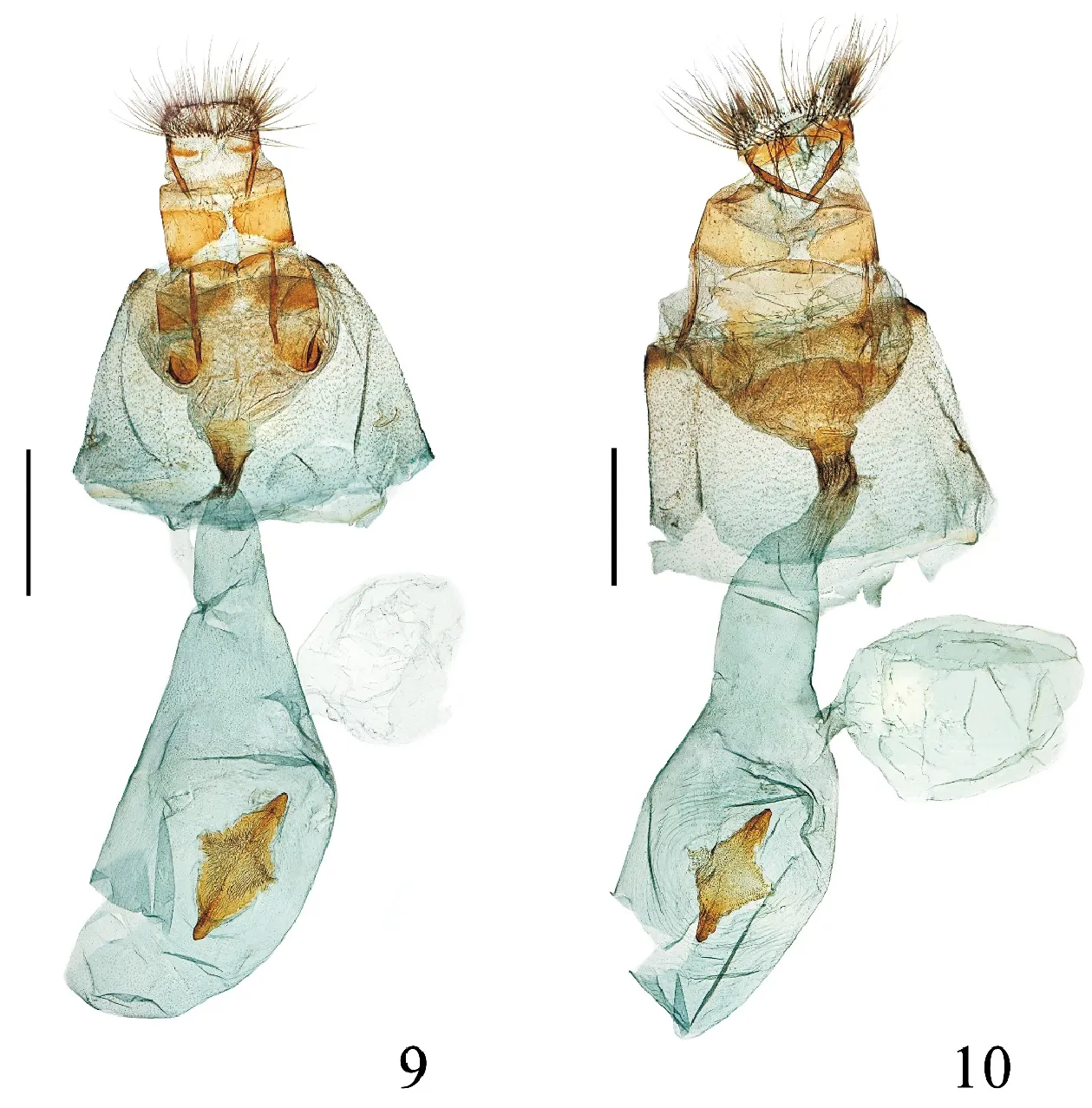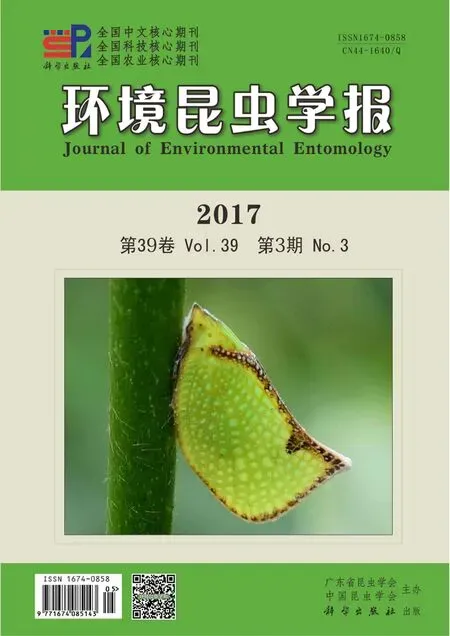Revision of the genus Pseudopagyda Slamka, 2013 (Lepidoptera: Pyraloidea: Crambidae: Pyraustinae) with the first reported females
CHEN Kai, ZHANG Dan-Dan
(Key Laboratory of Biodiversity Dynamics and Conservation of Guangdong Higher Education Institute, the Museum of Biology, School of Life Sciences, Sun Yat-sen University, Guangzhou 510275, China)
Revision of the genusPseudopagydaSlamka, 2013 (Lepidoptera: Pyraloidea: Crambidae: Pyraustinae) with the first reported females
CHEN Kai, ZHANG Dan-Dan*
(Key Laboratory of Biodiversity Dynamics and Conservation of Guangdong Higher Education Institute, the Museum of Biology, School of Life Sciences, Sun Yat-sen University, Guangzhou 510275, China)
The genusPseudopagydaSlamka, 2013 is revised.Two species,Microstegaacutangulata(Swinhoe, 1901) andPioneaingentalisCaradja, 1925, are transferred to this genus.Females of two species of the genus are firstly reported.A key to the species is provided based on male, along with diagnoses and redescription.Illustrations of adults and genitalia are provided.
Pyraustinae;Pseudopagyda; female
Introduction
The genusPseudopagydawas erected by Slamka (2013) for a single species,MicrostegahomoculorumBänziger, 1995.Slamka also suggested thatMicrostegaacutangulata(Swinhoe, 1901) should belong toPseudopagyda.By checking our collections and the types ofPioneaingentalisCaradja, 1925, we have confirmed thatM.acutangulataandP.ingentalisshould belong toPseudopagyda.Up to date,Pseudopagydacomprises three species (including two newly combined species in this paper) and distributes in the Oriental region (Caradja, 1925; Bänziger, 1995).One specimen ofP.homoculorumwas captured on Crimean coast, Ukraine.It was considered to immigrate from East Asia by ship or other vectors (Slamka, 2013).
The purpose of this paper is to refine the definition of the genus, present an identification key to allPseudopagydaspecies mainly based on male genitalia, redescribe all species and describe female of two species for the first time.
Material and methods
The specimens studied are all deposited at the Museum of Biology, Sun Yat-sen University, Guangzhou (SYSBM), except for those specified with the Insect Collection of the College of Life Sciences, Nankai University, Tianjing (NKUM), Institute of Zoology, Academia Sinica, Beijing, China (IOZ) and the “Grigore Antipa” National Museum of Natural History, Bucharest, Romania (MNHGA).Slides of genitalic dissections were prepared according to Robinson (1976).Genitalia terms used in morphological descriptions follow Klotz (1970), Munroe (1976), Maes (1995) and Kristensen (2003).The adult pictures were made using the Canon EOS 1DX camera in combination with the Helicon Remote; the genitalia pictures were taken using Zeiss Axio Scope A1 in combination with a Zeiss AxioCam camera and the Axio Vision SE64 programme on a Windows PC; source images were then aligned and stacked on Helicon Focus.All the pictures were edited with Adobe Photoshop CS5.
Taxonomy
PseudopagydaSlamka, 2013
PseudopagydaSlamka, 2013: 30.
Type species:MicrostegahomoculorumBänziger, 1995, by original designation.
Diagnosis.Species ofPseudopagydacan be recognized superficially by yellowish wings with lines fulvous and distinct subterminal line of forewing arched to about 4/5 CuA2, then concave to 4/5 posterior margin.In the male genitalia, the campanulate uncus with margin densely hairy, the long, club-shaped editum distally inflated and densely set with thick needle-shaped setae and dorsal sacculus with a pointed process are diagnostic for the genus.The female genitalia are characterized by the short ductus bursae and the large, drop-shaped corpus bursae.
Description.Head.Frons yellowish brown, laterally with white bands.Vertex with moderately raised scales projecting between antennae.Labial palpus brown, contrastingly white at base ventrally, obliquely upturned with the third segment porrect.Maxillary palpus yellowish brown.Thorax.Yellow.Legs unmodified.Foreleg brown, tibia white with a brown cross band in the middle, tarsus white; midleg pale brown, tibia and tarsus white ventrally; hindleg pale yellow, inner mid-spur longer than other inner spurs.Forewing subtriangular, termen gently arched.Hindwing fan-shaped, costa margin translucent whitish.Frenulum single in male, with two acanthae in female.Wing venation.Forewing with cell about half length of wing; R1free, from 2/3 to 4/5 of anterior margin of cell, R2free but adjacent to stem of R3+R4at about basal half, R3and R4stalked to about 2/3, R4to just before apex, R5close to stalked R3+R4at base then diverging; M1moderately close to R5at base, M2widely separate from M1, closing vein curved-concave, M2, M3and CuA1from posterior angle of cell, M3closer to M2at base than to CuA1, then diverging; CuA2from about 2/3 of posterior margin of cell; 2A forming complete loop and distally recurved before joining 1A.Hindwing with cell about 1/3 length of wing, Sc+R1and Rs anastomosing for 1/3 beyond end of discal cell, Rs and M1short-stalked at base, closing vein concave; M2, M3and CuA1from posterior angle of cell, parallel at base then diverging; 1A, 2A, 3A present.Abdomen.Slender, usually yellowish, sometimes dark brown with the anterior two segments pale yellow.Male genitalia.Uncus large, campanulate, apex flat or weakly bifid, margin area hairy.Tegumen near quadrate.Vinculum U-shaped.Saccus short and rounded.Valva tongue-shaped, gradually narrow from base to apex, slightly upcurved, making an angle about 40 degree with tegumen; transtilla triangular, dorsally set with setae; costa curved; sacculus broad, dorsal margin with a pointed process medially or subterminally; editum lamellate, club-shaped, distally inflated and set with thick, needle-shaped modified setae; sella absent.Juxta nearly heart-shaped, dorsal margin weakly bifid or deeply divided medially.Phallus short and broad, cornuti at distal end with a cluster of large spines ventrally.Female genitalia.Ovipositor lobes flat, set with dense setae.Anterior apophysis slightly longer than posterior apophysis, all sclerotized.Antrum funnel-shaped, sclerotized.Colliculum ring-shaped, with ductus seminalis arising from beside of anterior end.Ductus bursae very short.Corpus bursae long, drop-shaped, signum rhomboid; accessory bursae arising from about posterior third of corpus bursae.
Biology.Male ofP.acutangulataandP.homoculorumare lachryphagous (tears drinkers).The hosts include human and large mammals such as zebu, water buffalo, Asian elephant, sambar deer and western grey kangaroo (Bänziger, 1995).
Distribution.Pseudopagydaoccurs in South China (Fig.1), India, Thailand and Malaysia.Only one specimen was captured in Ukraine (Slamka, 2013).

Fig.1 Distribution of the Pseudopagyda species in China● P.acutangulata; ▲P.ingentalis;■P.homoculorum.
Putative apomorphies.ExternallyPseudopagydacould be recognized by the wing pattern with a distinct subterminal line.However, two species,BotysaureolalisLederer, 1863 andPaligacontractalisWarren, 1896, have the similar wing colour and wing pattern toPseudopagyda.There are no obvious synapomorphy externally.Therefore, we speculate that the characteristic genitalia structures described at diagnosis of the genus are the synapomorphies.
Key to thePseudopagydaspecies based on males
1 Wingspan 23-25 mm; wing colour pale yellow; pointed process of dorsal sacculus straight, with base broad (Figs.5, 8)P.homoculorum
- Wingspan more than 25 mm; wing colour yellow; pointed process of dorsal sacculus with apex weakly curved, with base not broad 2
2 Uncus distally bifid, forming two small tips; distal third of dorsal sacculus sinuate and spinulose (Fig.6)P.acutangulata
- Uncus distally not bifid, weakly concave; distal third of dorsal sacculus inflated, densely set with short spines (Fig.7)P.ingentalis

Figs.2-5 Adults of Pseudopagyda spp.2, P.acutangulata, ♂, Mt.Simianshan; 3-4, P.ingentalis; 3, ♂, Mt.Dadongshan; 4, ♂, lectotype, photo by Mihai Stănescu (MNHGA).5, P.homoculorum, ♂, Nabang.(Scale bars=1 cm)
Pseudopagydaacutangulata(Swinhoe, 1901), comb.nov.
Figs.1, 2, 6, 9
PioneaacutangulataSwinhoe, 1901: 26.
Microstegaacutangulata(Swinhoe): Bänziger, 1995: 269.
Diagnosis.Pseudopagydaacutangulatais similar toP.homoculorumandP.ingentalisexternally.The wing pattern is indistinguishable from those of the latter two.However, the background colour of wing, similar toP.ingentalis, is darker than that ofP.homoculorumand the wingspan is larger thanP.homoculorum.In the male genitalia, it is characterized by the campanulate uncus distally bifid, the pointed process of sacculus usually curved (not obvious in Fig.6) and the distal sacculus with sinuate and spinulose dorsal margin, rather than flat, smooth inP.homoculorum, or inflated, with short spines inP.ingentalis.In the female genitalia, the weakly sclerotized antrum with a convex sclerite each side interiorly and the ductus bursae extremely short are diagnostic forP.acutangulata.
Description.Head and thorax as in the genus.Wingspan 25-33 mm.Wings yellow, lines fulvous.Forewing broadly triangular with termen moderately arched.Antemedial line gently curved or straight from about 1/4 costa to 1/3 posterior margin; orbicular stigma present, sometimes faint; reniform stigma a fulvous, slightly curved streak; posterior angle of cell outwardly followed by a fulvous mark; postmedial line from about 2/3 costa, straight to basal third of M2, then arched to beyond basal half of CuA1, bent inwardly to 1/3 CuA2, then straight to 2/3 posterior margin; subterminal line from distal end of R2, arched to about 4/5 CuA2, then concave to 4/5 posterior margin; fringe yellowish brown.Hindwing fan-shaped, costa and posterior margin translucent whitish, lines and fringe as in forewing.Abdomen.Yellow dorsally, segments with posterior margin tinged with white, sometimes segments darkened except the basal two.Male genitalia.Uncus apex bifid and forming two small tips.Valva weakly narrow to apex; sacculus distally overlaid by a slender, rodlike structure pointed to base of editum, dorsal margin of sacculus somewhat twisted, strongly sclerotized, with basal third moderately concave, spinulose, medially with a pointed, curved process, distal third sinuate, spinulose; editum with distal third inflated.Juxta heart-shaped, distally weakly divided medially.Cornuti with a cluster of sparse spines.Female genitalia.Antrum gently sclerotized, with two convex sclerites laterally.Colliculum narrow in the middle.Ductus bursae rather short, weakly wrinkled.Corpus bursae long, spinulose; signum with two longitudinal arms longish, bearing carina, two transverse arms short and blunt, bearing spinules.
Material examined.China.Zhejiang: 1♂, Mt.Tianmushan, Lin’an, 30.31°N 119.44°E, alt.295 m, 11.V.2012, coll.Li Jinwei; 2♂, Kaishanlaodian, Mt.Tianmushan, alt.1140 m, 17.VIII.1999, coll.Li Houhun (NKUM); 1♂, Chanyuan Temple, Mt.Tianmushan, alt.350 m, 20.VIII.1999, coll.Li Houhun (NKUM); 1♂, Sanmuping, Mt.Tianmushan, alt.800 m, 28.VII.2011, coll.Du Xicui, genital slide No.SYSU0198; Jiangxi: 1♂, Xiaoxidong, Mt.Jinggangshan, 1.VI.2011, coll.Xie Weicai; 1♂, Main Peak, Mt.Jinggangshan, 30.VI.2011, coll.Li Jinwei, genital slide No.genital slide No.CXH12196; 10♂, 2♀, Mt.Guanggushan, Wuzhifeng Country, Shangyou, 25.92°N 114.05°E, alt.846 m, 22.VI.2015, coll.Chen Kai, genital slide No.SYSU0016, 0068 (♂), 0080, 0907 (♀); 7♀, Daqiutian, Mt.Jiulianshan, Longnan, alt.500 m, 31.VIII.2007, coll.Pang Hong, genital slide No.HFX08050, 08051, 08053, 08151-08154; 1♂, 2♀ (one female lost abdomen), Mt.Jiulianshan, 24.54°N 114.46°E, alt.625 m, 27-28.IV.2012, coll.Li Jinwei, genital slide No.SYSU0906 (♀); Hubei: 3♂, 1♀, Maoba, Mt.Xingdoushan, Enshi, alt.780 m, 30.VII.2012, coll.Fu Xiaobing and Zhang Jun, genital slide No.SYSU0197 (♂); 1♂, 1♀, Maoba, Lichuan, alt.700 m, 28-30.VII.1999, coll.Li Houhun (NKUM); 1♀, Mahe Country, Xianfeng, alt.400 m, 24.VII.1999, coll.Li Houhun (NKUM); 1♂, Pingbaying, Xianfeng, alt.280 m, 22.VII.1999, coll.Li Houhun (NKUM); Hainan: 1♂, Bawangling, 19.05°N 109.07°E, alt.592 m, 9.V.2013, coll.Li Jinwei, genital slide No.SYSU0058; 1♂, Bawangling, 19.06°N 109.05°E, alt.169 m, 10.V.2013, coll.Chen Xiaohua; 1♂, Bawangling Natural Reserve, 19.12°N 109.08°E, alt.161 m, 7.VI.2015, coll.Cong Xinpei, Guan Wei and Hu Sha (NKUM); 1♀, Tianchi restore, Jianfengling, 10.V.2011, coll.Yang Lijun and Yang Lifeng, genital slide No.SYSU0059; Chongqing: 2♂, Xiaonanhai, Qianjiang, alt.370 m, 21.VII.2012, coll.Xu Lijun and Zhang Jun; 2♂, Wangxiangtai, Mt.Simianshan, alt.900 m, 18.VII.2012, coll.He Guiqing, genital slide No.SYSU0199; 1♂, Laosimian, Mt.Simianshan, alt.1280 m, 12.VII.2012, coll.He Guiqing; 1♂, Tudiyan, Mt.Simianshan, alt.1200 m, 15.VII.2012, coll.He Guiqing; 1♂, Tiantangba, Mt.Simianshan, 28.64°N 106.35°E, alt.921 m, 13.VII.2016, coll.Chen Kai; 1♂, Dawopu, Mt.Simianshan, 28.58°N 106.35°E, alt.1059 m, 12.VII.2016, coll.Chen Kai; Guizhou: 5♂, Heiwan, Jiangkou, alt.600 m, 27-28.VII.2001, coll.Li Houhun and Wang Xinpu (NKUM); 1♂, Heiwan, Mt.Fanjingshan, alt.530 m, 2.VI.2002, coll.Wang Xinpu (NKUM); 10♂, Mt.Fanjingshan, Jiangkou County, 25-26.VIII.2012, coll.Chen Xiaohua and Li Jinwei, genital slide No.SYSU0011, 0018; 1♂, 1♀, Suoluo, Chishui, alt.240 m, 21-22.IX.2000, coll.Yu Haili (NKUM); 4♂, Baishao, Kuankuoshui, alt.800 m, 10-12.VIII.2010, coll.Du Xicui, genital slide No.SYSU0200; Yunnan: 2♂, Bawan, Baoshan, alt.1040 m, 9.VIII.2007, coll.Zhang Dandan, genital slide No.SYSU0005; 4♂, 1♀, Baihualing, Baoshan, alt.1520 m, 11,13.VIII.2007, coll.Zhang Dandan; 1♂, Dahaoping, Tengchong, alt.2020 m, 6.VIII.2007, coll.Zhang Dandan, genital slide No.SYSU0905; 2♂, 55 km site, Xishuangbanna Botanic Garden, alt.659 m, 29.V.2015, coll.Tao Manfei, genital slide No.SYSU0903; 1♂, Longmen Village, Mengla County, 23.VII.2011, coll.Li Jinwei, genital slide No.SYSU0902.
Distribution.China (Zhejiang, Jiangxi, Hubei, Hainan, Chongqing, Guizhou, Yunnan), India, Thailand, Malaysia.
Pseudopagydaingentalis(Caradja, 1925), comb.nov.
Figs.1, 3, 4, 7
PioneaingentalisCaradja, 1925: 366.
Diagnosis.Pseudopagydaingentalisis similar toP.acutangulataandP.homoculorumexternally.However,P.ingentalishas the largest wingspan (31-35 mm) within the genus.In the male genitalia,P.ingentaliscan be distinguished fromP.acutangulataby the uncus weakly concave but not bifid, fromP.homoculorumby the pointed and weakly curved process of sacculus with base not contrastingly broad.It differed from both species by the distal third of dorsal sacculus inflated and set with distinct spines.
Description.Head and thorax as in the genus.Wingspan 31-35 mm.Wings yellow, lines fulvous.Wing pattern of both forewing and hindwing similar toP.acutangulataandP.homoculorum, only differed by the posterior end of postmedial line of forewing more close to subterminal line.Abdomen.Yellowish, posterior margin of segments tinged with white.Male genitalia.Uncus apex weakly concave, sometimes forming inconspicuously processes laterally.Valva weakly narrow to apex; with sacculus broad, distally overlaid by a long, rodlike process; dorsal margin of sacculus twisted and sclerotized, with basal third gently concave and densely spinulose, medially with a long, pointed process, weakly curved with base slightly broad, distal third inflated, set with dense spines; editum with distal half inflated.Juxta heart-shaped, distally weakly concave in the middle.Cornuti with a cluster of densely spines.Female unknown.
Type.Lectotype:♂, China.Guangdong: Lienping, ?.VI.?, Des.Car[adja], genital tube No.186085 (MNHGA).Allolectotype: ♀, China.Guangdong: Lienping, Septemb[er], Des.Car[adja] & Dr.A.Popescu-Gorj (MNHGA).Paralectotype: ♀, China.Guangdong: Canton, 24.VII.?, Des.Car[adja] & Dr.A.Popescu-Gorj (MNHGA).
Other material examined.China.Guangdong: 1♂, Mt.Dadongshan, alt.650 m, 25.VI.2004, coll.Zhang Dandan, genital slide No.ZDD03258; Guangxi: 1♂, Gaozhai, Xing’an, 28.VIII.2011, coll.Li Jinwei, genital slide No.SYSU0901.
Distribution.China (Guangdong, Guangxi).
Pseudopagydahomoculorum(Bänziger, 1995)
Figs.1,5, 8, 10
MicrostegahomoculorumBänziger, 1995: 267.
Pseudopagydahomoculorum(Bänziger): Slamka, 2013: 31.
Diagnosis.Pseudopagydahomoculorumhas the smallest wingspan (23-25 mm) and the palest yellow wing colour within the genus.In the male genitalia,P.homoculorumcan be distinguished fromP.acutangulataandP.ingentalisby the valva distally narrower, the straight, pointed process of dorsal sacculus with broad base and the phallus medially with a bundle of spinules in vesica.In the female genitalia, it differs fromP.acutangulataby a well sclerotized antrum without convex sclerite, the colliculum gently narrow medially and the longish ductus bursae.
Description.Head and thorax as in the genus.Wingspan 23-25 mm.Wings pale yellow, lines fulvous.Wing pattern similar toP.acutangulata.Abdomen.Yellow dorsally, segments with posterior margin tinged with white, sometimes segments darken except the basal two.Male genitalia.Uncus with obtusely rounded or slightly concave apex.Valva distinctly narrow to apex; sacculus broad, distally with a small sclerotized process, long triangular, sometimes set with few tiny projection; dorsal margin of sacculus somewhat twisted, deeply sclerotized, basal third moderately concave and densely spinulose, beyond half with a pointed process, straight, with base contrastingly broad and usually dentate, distal third flat, weakly dentate; editum club-shaped, distally inflated and densely set with modified setae, thick and pointed.Juxta heart-shaped, dorsally bifid in the middle.Vesica in distal half with a strip-shaped bundle of spinules, cornuti with a cluster sparse spines.Female genitalia.Antrum well sclerotized.Colliculum gently narrow in the middle.Ductus bursae short, gradually broad to corpus bursae, densely spinulose.Corpus bursae spinulose; signum with longitudinal two arms large and long, bearing indistinct carina, vanishing in the middle, transverse two arms short and pointed.
Material examined.China.Guangxi: 2♂, Nonggang Reserve, 21.VIII.2011, coll.Li Jinwei; 1♂, Nonggang Reserve, 21.VIII.2011, coll.Zhang Dandan; 9♂, 2♀, Nonggang, Longzhou, 22.47°N 106.96°E, alt.271 m, 19.IV.2012, coll.Li Jinwei, genital slide No.SYSU0006, 0013, 0033 (♂), 0079, 0908 (♀); 1♂, Nonggang, Longzhou, alt.188 m, 31.VII.2011, coll.He Guiqing; 1♂, Longrui Reserve, 18.VIII.2011, coll.Cheng Muchun; 1♂, Longrui Reserve, 19.VIII.2011, coll.Yang Lijun; 1♂, Bainan Country, Napo County, 23.05°N 105.80°E, alt.300 m, 23.VII.2013, coll.Chen Xiaohua, genital slide No.SYSU0069; Yunnan: 11♂, Nabang, Yingjiang County, 24.75°N 97.56°E, alt.239 m, 27.V.2016, coll.Duan Yongjiang, genital slide No.SYSU0172, 0904; 1♂, Dazhong Villa, Xishuangbanna, alt.840 m, 24.V.2015, coll.Tao Manfei; 1♂, Dahaoping, Tengchong, alt.2020 m, 6.VIII.2007, coll.Zhang Dandan, genital slide No.SYSU0904; 1♂, Cangyuan, 18.V.1980, coll.Song Shimei (IOZ); 1♀, Menglun, Banna, alt.650 m, 30.IV.1964, coll.Zhang Baolin (IOZ).
Distribution.China (Guangxi, Yunnan), Thailand, Ukraine (immigrant).
Discussion
Morphological characters show that these three species are congeneric.According to our collections,P.acutangulatahas much wider distribution in China andP.homoculorumis sympatric withP.acutangulatain west Yunnan.P.acutangulataalso occurs in north of Thailand, west of Malaysia and northwest of India (Bänziger, 1995).P.ingentalisis only found in north of Guangdong and Guangxi currently.
Wangetal.(2003) reported thatP.ingentalisfrom Fujian, Hubei, Guangdong, Hainan and Sichuan.But from the picture of male genitalia, the species should beP.acutangulata.Combining the wingspan described, we believe that might be a mixture of two species includingP.acutangulataat least.Therefore, we do not add these distribution data in this paper.
In Bänziger’s research, he placedhomoculorumandacutangulatain genusMicrostegaand transferredBotysaureolalisLederer, 1863 andPaligacontractalisWarren, 1896 toMicrostega, which is currently a synonym ofParatalanta.Zhangetal.(2013) pointed out that these species should not belong toParatalantabecause they do not share any synapomorphic character with species ofParatalanta.Slamka (2013) erected the genusPseudopagydaforhomoculorumand suggested thatMicrostegaacutangulata,BotysaureolalisandPaligacontractalisshould belong toPseudopagyda.By checking the type materials ofPyralisochrealisMoore, 1877 (a junior synonym ofBotysaureolaliswhose type is not found in Lederer’s collection, Bänziger, 1995) andPaligacontractalis, we found that these two species share no synapomorphy in both male and female genitalia with species ofPseudopagyda.The similar wing pattern and club-shaped editum indicate they might be closely related toPseudopagyda.

Figs.9-10 Female genitalia of Pseudopagyda spp.9, P.acutangulata, genitalia slide no.SYSU0907;10, P.homoculorum, genitalia slide no.SYSU0908.(Scale bars=1 mm)
Acknowledgments
Grateful thanks go to Dr Mihai Stănescu (“Grigore Antipa” National Museum of Natural History, Bucharest, Romania), who provided information of types and excellent images ofP.ingentalis, to Prof.Houhun Li (Nankai University, China) for the loan materials, to Dr Xicui Du (Southwest University, China), who kindly provided some specimens.We also thank Dr Hong Pang (Sun Yat-sen University, China) for photographing the adult specimens.This project was supported by the National Natural Science Foundation of China (Grant No.31672330), the key project of Science-technology basic condition platform from the Ministry of Science and Technology of the People’s Republic of China (Grant No.2005DKA21402) and the specimen platform of China, teaching specimens sub-platform, Web, http://mnh.scu.edu.cn/.The data in this research partly comes from the database of National Digital-Museum of Animal Specimens.
Bänziger H.Microstegahomoculorumsp.n.the most frequently observed lachryphagous moth of man (Lepidoptera, Pyralidae: Pyraustinae) [J].RevueSuissedeZoologie,Genève, 1995, 102 (2): 265-276.
Caradja A.Ueber Chinas Pyraliden, Tortriciden, Tineiden nebst kurze Betrachtungen, zu denen das Studium dieser Fauna Veranlassung gibt (EinebiogeographischeSkizze)[J].MemoriileSectiuniiStiintifice.AcademiaRomana, 1925, 3(7): 257-383, pls.1-2.
Klotz AB.Lepidoptera.In: Tuxen SL, ed.Taxonomist’s Glossary of Genitalia In Insects.Second Revised and Enlarged Edition [C].Copenhagen: Munksgaard, 1970: 115-130.
Kristensen NP.Skeleton and muscles: Adults.In: Kristensen NP, ed.Lepidoptera, Moths and Butterflies.Vol.2: Evolution, Systematics, and Biogeography.Handbook of Zoology IV (35) [C].Berlin and New York: Walter de Gruyter, 2003: 39-131.
Maes KVN.A comparative morphological study of the adult Crambidae (Lepidoptera, Pyraloidea) [J].BulletinetAnnalesdelaSociétéRoyaleBelged’Entomologie, 1995, 131: 383-434.
Munroe EG.Pyraloidea (in part).In: Dominick RB,etal., eds.The Moths of America north of Mexico Including Greenland, 13.2A [C].London: E.W.Classey and the Wedge Entomological Foundation, 1976:1-78.
Robinson GS.The preparation of slides of Lepidoptera genitalia with special reference to the Microlepidoptera [J].Entomologist’sGazette, 1976, 27: 127-132.
Slamka F.Pyraloidea of Europe 3, Pyraustinae and Spilomelinae [M].Bratislava, 2013:1-357.
Swinhoe C.New genera and species of Eastern and Australian moths [J].AnnalsandMagazineofNaturalHistory,includingZoology,BotanyandGeology,London, 1991, 8: 16-27.
Wang JS, Song SM, Wu YY,etal.Fauna of Pyralidae of Wuyishan Nature Reserves in China [M].Beijing: China Science and Technology Press, 2003: 1-328.
Zhang DD, Cai YP, Li HH.Taxonomic review of the genusParatalantaMeyrick, 1890 (Lepidoptera: Crambidae: Pyraustinae) from China, with descriptions of two new species [J].Zootaxa, 2014, 3753(2): 118-132.
国家自然科学基金(31672330);国家科技基础条件平台工作重点项目(2005DKA21402)
陈凯,男,博士研究生,主要从事昆虫系统学研究
Received: 2017-03-28; 接受日期Accepted: 2017-04-21
拟尖须野螟属PseudopagydaSlamka, 2013修订(鳞翅目:草螟科:野螟亚科)及雌性的首次记录
陈 凯,张丹丹*
(生物多样性演化与保护广东普通高校重点实验室,中山大学生物博物馆,中山大学生命科学学院, 广东广州,510275)
对拟尖须野螟属进行了修订,Microstegaacutangulata(Swinhoe, 1901)和PioneaingentalisCaradja, 1925被移入该属,并首次描述了该属两种雌性。提供了基于雄性特征的分种检索表和属、种的鉴定特征,进行了种的重新描述,并提供了成虫及外生殖器图版。
野螟亚科; 拟尖须野螟; 雌性
S433.4
A
1674-0858(2017)03-0580-08
陈凯,张丹丹.拟尖须野螟属PseudopagydaSlamka, 2013修订(鳞翅目:草螟科:野螟亚科)及雌性的首次记录[J].环境昆虫学报,2017,39(3):580-587.
*通讯作者Author for correspondence,E-mail: zhangdd6@mail.sysu.edu.cn

